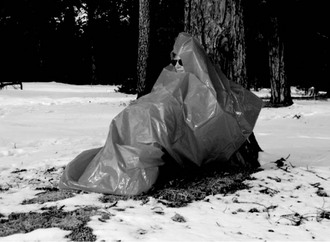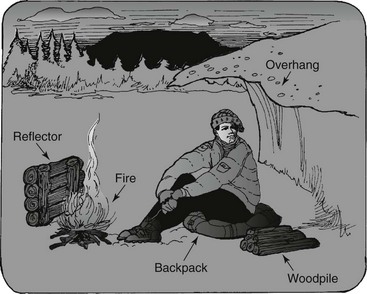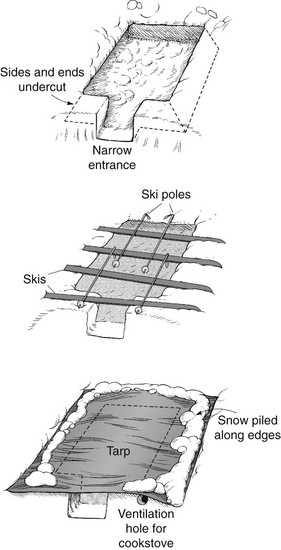Survival
Cold Weather Survival
1. How quickly is the shelter needed? (Or, how much time do you have to build the shelter?)
2. Is there a sick or injured person that needs shelter?
3. How many people will be in the shelter at one time? (How big does the shelter need to be?)
4. What is the length of time you anticipate using the shelter? (One should always overestimate.)
1. Is the shelter needed solely for warmth or also for protection from wind and snow?
2. Where should the shelter be built?
3. What are the avalanche or rock-fall risks in the area?
4. Avoid exposed windy ridges.
5. Avoid any areas at risk for flooding (drainages, dry riverbeds).
6. Avoid low-lying areas, such as basins that tend to collect the colder night air.
7. A timbered area provides protection from foul weather, but can also block the sun.
8. Select a shelter site where there is access to water.
9. In windy conditions, a shelter should be built with the entrance at 90 degrees to the prevailing winds.
10. Shelters can be built in small caves or indentations in a rock outcropping, in a “tree well,” or under downed trees.
11. Environmental resources that can be used for building and insulating a shelter include small trees, branches, thick grass, or leaf piles.
12. Snow is a good insulator because it traps the warmed air generated by body heat; however, direct contact with snow must be avoided.
13. An insulation barrier between the snow and an individual can be created by using equipment, such as a closed cell foam pad or backpack, or it can be created by piling up small tree branches and boughs.
14. The insulation layer if using tree boughs should be 25.4 to 30.5 cm (10 to 12 inches) thick to allow for compression when sitting or lying on this layer.
Types of Shelters
Tarpaulins
1. Cut open a 3- to 4-mil (1 mil = 0.0254 mm [0.001 inch]) large, heavy-duty plastic bag to form a tarp.
2. Fifty feet of cordage is also needed.
3. A tarp can be rigged into either a lean-to or an A-frame shelter. In cold weather, an A-frame provides the best method for retaining heated air.
4. Tie cordage between two trees situated approximately 3 m (10 feet) apart. The tree at the entrance end should be a large tree if a fire is going to be made (see later). If there is a slight slope to the terrain, the head end of the shelter should be uphill.
5. Tie the foot end of the cord 45.2 to 61 cm (18 to 24 inches) above the ground.
6. Tie the head end of the cord 1.1 to 1.2 m (3.5 to 4 feet) above the ground.
7. Fold the tarp in half over the cord, and secure both ends to the cord.
8. Ideally, place the foot end next to a large tree, which offers a natural closure for that end of the shelter.
9. Secure the edges of the sides of the tarp to the ground by tying them to rocks or other trees.
10. To prevent heat from escaping along the edges of the A-frame, the sides should have an overlapping flap on the ground that can be secured with dirt, snow, or rocks.
11. Close the foot end to prevent heat escape.
12. Leave the front end, or entrance, open if a fire is going to be built.
13. If there will be no fire, the entrance can be at least partially closed off by stacking a backpack or tree branches in the opening.
14. Insulate the sides of the constructed shelter by thatching brush, branches, or broad leaves (e.g., the first layer is placed at ground level, with each successive layer overlapping the one below it).
Plastic Bag Shelters (Fig. 59-1)

FIGURE 59-1 Example of two large plastic bags used to form a one-person survival shelter. (Courtesy Peter Kummerfeldt.)
1. Large, heavy-grade (3 to 4 mil) orange plastic 208.2-L (55-gallon) drum liners make good short-term emergency shelters.
2. Alternatively, heavy-duty trash bags can be used (although orange drum liners have the advantage of increased durability and visibility for rescue purposes).
3. Cut an opening in the bottom end of the bag that is just large enough for your head, and then pass the bag over your head so that your face is at the opening.
4. When creating the hole, cut the plastic at 90 degrees to the fold to reduce the likelihood of the bag tearing along the seam.
5. A second bag, pulled over the legs, used in conjunction with the system described above, will form a one-person survival shelter.
Space Blankets and Bags
1. Space blankets and bags are lightweight, inexpensive, and compact, but are of limited value in an emergency.
2. A space blanket is frequently difficult to get out of its package, unfold, and manage in windy conditions.
3. Depending on the brand, space blankets are usually too small to fully encase an adult.
4. When wrapped up, the survivor will find that a space blanket makes a shelter that is so noisy that even an approaching aircraft or ground search party may not be heard.
5. Space blankets tear easily when they are nicked or punctured.
6. The space bag has the same flaws as does the space blanket, except that it is easier to encase an individual and for that person to stay encased.
Tube Tents (Fig. 59-2)
1. Tube tents are inexpensive polypropylene sleeves that are 2.4 m (8 feet) long and provide a tubular shelter that is 0.9 to 1.5 m (3 to 5 feet) high, depending on the brand.
2. A tube tent can be pulled over the body to provide a quick shelter or pitched as a “pup tent.” To do this, find two anchors (e.g., rocks, trees) that are the proper distance apart, tie a line to one of them, spread the tent out along the length of the line, run the line through it, and then tie off the other end of the line. The height of the line should be such that the tent can be spread out to accommodate the occupant.
3. To avoid ripping, the tent plastic should be 3 to 4 mil thick.
4. Tube tents can be improvised from two plastic 208.2-L (55-gallon) drum liners, which are 3 to 4 mil thick, or from large, heavy-grade household trash bags by opening up the closed end of one bag, sliding it into the open end of the second bag, and then duct taping the bags together.
Tents and Bivouac Sacks
1. Tents are generally comfortable and dry, but in very cold weather they are not as warm as snow shelters.
2. Tents are preferable to snow shelters at mild temperatures, during damp snow conditions at temperatures above freezing, or when the snow cover is minimal.
3. Bivouac sacks are carried by climbers on long alpine-style climbs or for emergencies. They are usually made of Gore-Tex or waterproof fabric and hold one or two persons. They pack small, are lightweight, and can easily be carried for an emergency shelter on any trip into the backcountry.
4. Many modern packs have extensions, so when used with a cagoule or mountain parka, form acceptable bivouac sacs. The cagoule is donned, and the backpack is pulled on the feet and legs, extending the top of the pack as high up the body as it can be placed.
Natural Shelters
1. Caves and alcoves under overhangs are good shelters and can be improved by building barrier walls with rocks, snow blocks, or brush to protect from wind.
2. In deep snow, large fallen logs and bent-over evergreens frequently have hollows underneath them that can be used as small snow caves.
3. Cone-shaped depressions around the trunks of evergreens (tree wells) can be improved by digging them out and roofing them over with evergreen branches or a tarp (Fig. 59-3).

FIGURE 59-3 Natural shelter.
Snow Shelters
Snow Trenches (Figs. 59-4 and 59-5)

FIGURE 59-4 Three-person snow trench.

FIGURE 59-5 Above-timberline snow trench.
1. A snow trench is the easiest and quickest survival snow shelter and the one least likely to make the diggers wet.
2. If a shovel, large tarp, structural support items (skis, poles, trees), and a small fire, candle, or stove are available, a trench can be created that is as comfortable as a snow cave.
3. It is easiest to dig a trench in a flat area. However, if the snow is deep enough, it can be dug out on an incline, keeping the trench itself level.
4. If possible, dig all the way to the ground. If the snow is too deep to dig to the ground, dig to a depth of 0.9 m (3 feet). If the snow is not deep enough, pile snow up around all four sides of the trench to make walls, until the total depth of the trench is 0.9 m (3 feet).
5. The trench width should be just slightly wider and 0.6 to 0.9 m (2 to 3 feet) longer than the person(s) that will be lying in the shelter. The additional length allows for a fire pit at one end of the shelter.
6. Ski poles, skis, or long tree branches are placed perpendicular to the length of the trench.
7. The trench is then covered with a tarp, leaving one end open for the entrance.
8. Secure the tarp on all sides by packing the edges into the snow.
9. Gently toss snow on top of the reinforced tarp to provide insulation to the shelter.
10. The snow pack on top should be 20.3 cm (8 inches) or more.
11. The object is to keep the maximal amount of snow around and over the trench for optimal insulation.
12. If the trench is going to be wide enough to accommodate more than one person, the entrance should still be only wide enough for one person to pass through at a time. A narrow entrance is easier to close off and helps contain heat within the shelter.
13. A barrier can be created at the entrance by stacking backpacks or snow blocks, or hanging a tarp across the opening.
14. When the entrance is closed, a small votive-size candle or stove and the occupants’ body heat will raise the interior temperature to -4° to -1° C (24.8° to 30.2° F).
15. Higher temperatures should be avoided so that clothing and bedding will not become wet from melting snow.
16. Ventilation is necessary to prevent build-up of carbon monoxide within the shelter.
17. Anywhere that deep snow has been wind packed, as happens above timberline, the trench can be roofed with snow blocks.
18. The blocks are cut to a width of 45.2 to 50.8 cm (18 to 20 inches), a depth of 10.2 cm (4 inches), and a length equal to the length of the snow saw.
19. They are then laid horizontally for a narrow trench or vertically for a wider trench, set as an A-frame, or laid on skis (see Fig. 59-5).
Snow Caves (Fig. 59-6)

FIGURE 59-6 A, Snow cave entrance. B, Snow cave partly closed with snow blocks. C, Interior of snow cave.
1. A shovel is the best item to use when digging a snow cave, although small snow caves large enough for one person can be dug with a ski or cooking pot.
2. The optimum site is a large snowdrift, often found on the lee side of a small hill.
3. Areas in avalanche zones must be avoided.
4. Ski poles, skis, or tree branches are poked in the snowdrift to a depth of 45.2 cm (18 inches) around the area that will be the outside walls of the cave.
5. The entrance is dug just large enough to crawl through and is angled upward toward the sleeping chamber (see Fig. 59-6).
6. After the entrance is dug with the shovel, the digger crawls inside, lies supine, and uses the shovel to excavate the chamber, which should be large enough for a stove and the number of occupants requiring shelter.
7. The snow is removed from the walls inside the shelter until the ends of the ski poles, skis, or tree branches are met. This ensures that the snow cave walls maintain a depth of 45.2 cm (18 inches), necessary to prevent collapse of the walls.
8. Because diggers tend to become wet, water-resistant or waterproof jackets and pants should be worn.
9. Pine branches or other natural materials can be used to cover the floor if a sleeping pad is not available.
10. The entrance to the snow cave can be blocked off using backpacks or blocks of snow.
11. If the group is large and there are several people available to dig out the cave, a larger entrance can be created, providing room for multiple diggers to excavate the interior.
12. The disadvantage is the larger opening that needs to be closed to maintain warmth inside the snow cave.
13. The cooking area for the snow cave can be in the entrance area outside the cave itself.
14. If cooking is going to be done inside the cave, a ventilation hole as large as a ski pole basket must be cut in the roof over the cooking area to provide adequate ventilation.
15. A snow cave large enough for two persons takes several hours to dig and therefore is not the primary choice of shelter in an emergency.
16. It can be built after a faster-improvised shelter is provided for the safety and well-being of the group.
Quinzhee (Snow Dome)
1. The snow is piled into a large dome 1.8 to 2.1 m (6 to 7 feet) in height and width and left to harden for a few hours. The waiting time allows the snow crystals to adequately consolidate so that the dome will not collapse when it is excavated.
2. After the settling time, the dome is dug out in the same method as described earlier for the snow cave.
3. Sticks can be used as spacers; walls should be 25.4 to 30.5 cm (10 to 12 inches) thick.
4. A low entrance is dug on one side, and from there the interior is carved out to make a dome-shaped room that is large enough to sleep three or four people.
5. The sleeping platform should be higher than the entrance.
6. Another method is to make a “form” (i.e., a pile of vegetation or equipment), cover this form with snow, allow the snow to set, and then open one end and remove the form.
Igloos (Fig. 59-7)

FIGURE 59-7 A to C, Stages of igloo construction.
1. An igloo requires one, or ideally two, snow saws and snow that is well packed and easy to cut into multiple uniform blocks.
2. This type of packed snow is found in wind-blown, treeless areas
3. Packed, consolidated snow can be created by stamping a large area of snow and letting it settle and harden for several hours
4. To mark the diameter of the igloo, a ski pole is held by the handle and the body turned so that the pole basket makes a large circle. This will outline the base of an igloo suitable for three people. The first snow blocks are cut from inside the circle. This will lower the floor so that fewer blocks are required for the dome.
5. At least two persons are needed for this project: one to cut and carry the blocks and the other inside the igloo to lay the blocks.
6. The blocks should be about 45.2 cm (18 inches) wide, 76.2 cm (30 inches) long, and 20.3 cm (8 inches) thick.
7. They are laid in a circle leaning in 20 to 30 degrees toward the center of the igloo, with the sides trimmed for a snug fit.
8. The tops of the first few blocks in the first circle are beveled so that a continuous line of blocks is placed down, with the first few blocks of each succeeding circle cocked upward (see Fig. 59-7, A).
9. A common error is to not lean the blocks inward enough, resulting in an open tower instead of a dome.
10. Gaps between the blocks are caulked with snow.
11. The dome should be 1.5 to 1.8 m (5 to 6 feet) high inside and can be closed with a single capstone of snow.
12. The entrance is dug as a tunnel underneath rather than through the edge of the igloo, preventing warm air from escaping (see Fig. 59-7, B and C).






